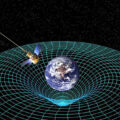
Image: CC by A-SA 4.0, Ildar Sagdejev, via Wikipedia Commons
Kinetic Energy (KE) pertains to the energy of an object of an object brought by motion. The object gains during the acceleration and maintains it unless the speed changes.
When we study topics on energy, we definitely encounter confusing terms. Other than kinetic energy, this physics discussion includes potential energy, heat, power, source, ionization, chemical energy, mechanical energy, thermal energy.
Taking a look at these topics needs some examples to better understand it. If you need to grasp this complex concept, there are some simple definitions to understand.
What is Energy?
Energy, simply put, signify the ability or power to move, think, or otherwise remain active. Also, we define energy as a usable power or even the sources that enable that power.
Without energy, an object doesn’t move, flames cannot flicker, and people cannot walk or think. Understanding the famous Theory of Relativity goes along with this discussion.
What Kinds of Energy are There?
Energy comes in many forms, fueled by many sources.
- Mechanical
- Magnetic
- Electrical
- Gravitational
- Ionization
- Chemical
- Nuclear
- Elastic
- Chromodynamic
- Mechanical wave
- Soundwave
- Radiant
- Rest
- Thermal
Within these forms, any object that has energy possess have kinetic or potential energy.
What is Kinetic Energy?

Image: CC 0 by Public Domain, Skitterphoto, via Pixabay
Kinetic energy remains as a term in physics used to describe the energy of an object in motion. The word “kinetic” comes from the Greek word that means motion.
A very basic definition of kinetic energy tells us that the energy an object has due to its motion. Also, the
work needed to accelerate an object to its velocity from a state of resting.
We usually say that kinetic energy means the energy of motion.
What is the Potential Energy?
Potential energy is not being used, but it is energy that could be used. The position of an object, or its parts, determine its potential energy.
For example, a roller coaster that’s flown down one slope and is sitting atop the next slope has potential energy. If it is “nudged” forward, it will fly down the tracks, using its potential energy to become kinetic energy.
What is Velocity?
Basically, velocity is the speed of motion of an object. The higher the speed, the higher the velocity of an object.
An object’s KE increases as its velocity increases.
What’s the Difference Between Kinetic Energy and Potential Energy?
The difference between kinetic energy and potential energy is whether or not the object is in motion. An object, like a frisbee in someone’s hand, has potential energy, but once it leaves the person’s hand and is in motion, it has KE.
Examples of Kinetic Energy
To further explain, we’ll offer a variety of examples of kinetic energy.

Image: CC 0 by Public Domain, Pamter, via Pixabay
Example 1
An airplane in flight has kinetic energy. The high velocity and large mass of the airplane mean it has significant kinetic energy.
Example 2
At the top of a hill, a downhill skier has potential energy. Once he is in motion, and gliding down the hills, his potential energy becomes kinetic motion, which increases as his velocity increases.

Image: CC 0 by Public Domain, Pexels, via Pixabay
Example 3
Using a hammer has both potential and kinetic energy at work. As you swing the hammer, you use KE.
That pause before a backswing happens when the potential energy “accumulates” in the hammer swing back toward the original position.
When the hammer head strikes the nail head, the velocity and power of the swing transfer into the hammer strike. You see this on how a nail gets driven into wood.
Example 4
A vehicle in motion uses KE to move it forward on the road. This object combines the forms of electric, mechanical, and gravitational energy.
The explains why fuel gas remains expensive. It even moves a heavy vehicle with liters of this ‘black gold’
Example 5
A marathon runner at the start line has potential energy. She has fueled up with food, water, and has the training background.
This ensures a whole lot of kinetic energy exerted once the starter pistol fires. Once the runner leaves the gate, she exerts KE.

Image: CC 0 by Public Domain, tookapic, via Pixabay
Example 6
A crawling baby appears as an example of KE. The child has potential energy until he starts moving.
At the time of the motion, the potential energy transfers into motion. Then, the baby moves forward via KE.
Example 7
A golf ball sitting on the golf tee has no energy. However, the golf club coming towards uses the potential energy from the backswing translated into kinetic energy of the forward motion.
This creates a potential for the golf ball to use KE. Moreover, this occurs once the velocity of the club sets it into motion.

Image: CC 0 by Public Domain, markusspiske, via Pixabay
The Kinetic Energy and Putting Them to Use
Any moving object has kinetic energy. The energy transferred from its position during the resting state remains as the kinetic energy of an object.
Or, more simply put, kinetic energy acts as the energy or power of an object in motion. Airplanes flying, cars driving, runners running holds the very basic examples of it.
Also, this explains why the task of nuclear engineers and chemical engineers requires heavy mastery of the skill. The same goes for industrial engineers and petroleum engineers.
Featured Image: CC by A-SA 4.0, Ildar Sagdejev, via Wikipedia Commons












Leave a Reply